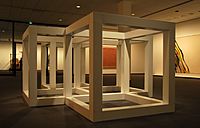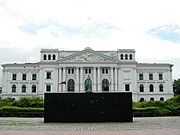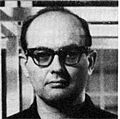Sol LeWitt facts for kids
Quick facts for kids
Sol LeWitt
|
|
|---|---|
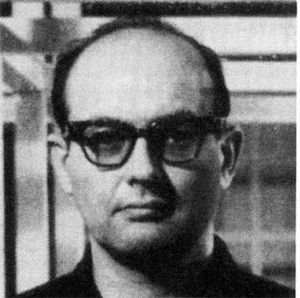
Sol LeWitt, c.1965
|
|
| Born |
Solomon LeWitt
September 9, 1928 Hartford, Connecticut, US
|
| Died | April 8, 2007 (aged 78) New York City, US
|
| Education | Syracuse University, School of Visual Arts |
| Known for | Painting, Drawing, Sculpture |
| Movement | Conceptual Art, Minimalism |
Solomon "Sol" LeWitt (born September 9, 1928 – died April 8, 2007) was an American artist. He was a key figure in art movements like conceptual art and minimalism.
LeWitt became famous in the late 1960s. He was known for his unique wall drawings and "structures." He preferred the word "structures" instead of "sculptures" for his 3D art. He worked with many different art forms. These included drawing, printmaking, photography, painting, and special art installations. His work has been shown in hundreds of exhibitions worldwide since 1965.
Contents
About Sol LeWitt's Life
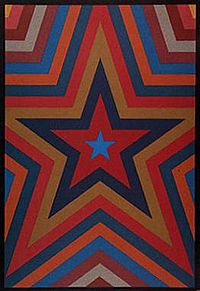
Sol LeWitt was born in Hartford, Connecticut. His family were Jewish immigrants from Russia. His father passed away when Sol was only six years old. His mother encouraged his artistic talent. She took him to art classes at the Wadsworth Atheneum in Hartford.
After college, LeWitt traveled to Europe in 1949. There, he saw many famous old paintings. He then served in the Korean War before moving to New York City in 1953. He set up his art studio on the Lower East Side. He also studied at the School of Visual Arts. For a year, he worked as a graphic designer for architect I. M. Pei.
In 1960, LeWitt took a job at the Museum of Modern Art (MoMA) in New York. This job greatly influenced his later artwork. He met many other artists there, like Robert Ryman and Dan Flavin. He also became friends with Eva Hesse and Robert Smithson.
LeWitt taught art at several schools in New York during the late 1960s. In 1980, he moved to Spoleto, Italy. He returned to the U.S. in the late 1980s. He lived in Chester, Connecticut. Sol LeWitt passed away in New York at age 78 due to cancer.
Sol LeWitt's Artworks
LeWitt is seen as a founder of both Minimal Art and Conceptual art. His art includes many two-dimensional and three-dimensional pieces. He created over 1200 wall drawings. He also made hundreds of works on paper. His structures include towers, pyramids, and geometric shapes. These artworks range from small book-sized pieces to huge outdoor installations.
LeWitt's Sculptures
In the early 1960s, LeWitt started making his "structures." This was his special word for his 3D art. He often used open, modular structures. These were based on the cube shape. The cube was a very important idea for him.
At first, he made wooden objects that were heavily painted. But in the mid-1960s, he decided to "remove the skin." This meant he wanted to show the basic structure. The simple, open cube became a main part of his 3D work. He started using open cubes made of twelve connected lines. From 1969, he made many of these modular structures very large. They were built from aluminum or steel by factories.
LeWitt decided on a standard design for his modular cubes around 1965. The empty space between the beams was much larger than the material itself. The ratio was about 8.5 to 1. He also chose to paint the material white instead of black. These choices were artistic decisions. But once he made them, he used them consistently. Museums even use LeWitt's modular cube works to teach children about math!
From the mid-1980s, LeWitt also made sculptures from stacked cinder blocks. He continued to create new designs within his own rules. In 1985, his first cement Cube was built in a park in Basel. Later, he designed many variations of concrete block towers. In the late 1990s, LeWitt started using curvy shapes and bright colors. This was a change from his usual geometric style.
In 2007, LeWitt designed 9 Towers. This was a huge cube made from over 1,000 light-colored bricks. It measured five meters on each side. It was installed in Sweden in 2014.
LeWitt's Wall Drawings
In 1968, LeWitt began creating art directly on walls. He made simple rules or diagrams for these works. They were first drawn with graphite pencil, then crayon, and later colored pencil. Finally, he used bright India ink washes and acrylic paint. Since his first wall drawing in 1968, thousands of his drawings have been made on walls around the world.
Between 1969 and 1970, he made four "Drawings Series." These used different combinations of basic lines. He used vertical, horizontal, diagonal left, and diagonal right lines. He applied different systems like 'Rotation' or 'Mirror' to create many variations.
For example, Wall Drawing #122 (1972) has 150 unique pairs of lines and arcs. These are placed randomly on the walls. Wall Drawing #260 at MoMA explores all possible two-part combinations of arcs and lines. Wall Drawing #792: Black rectangles and squares (1995) shows his interest in art and architecture. It creates an irregular grid pattern across two floors.
When LeWitt moved to Italy in the late 1970s, he started using vivid ink washes. He was inspired by the old frescoes of Italian painters like Giotto. In the late 1990s, he made very colorful acrylic wall drawings. Even though they look playful and random, they follow strict rules. For instance, the colored sections are a standard width. Also, no two sections of the same color can touch.
In 2005, LeWitt started "scribble" wall drawings. These drawings required assistants to fill wall areas by scribbling with graphite. The scribbling had six different levels of density. These densities created a sense of three dimensions. The largest scribble wall drawing, Wall Drawing #1268, is at the Albright–Knox Art Gallery.
LeWitt's wall drawings are usually made by other people, not the artist himself. He believed the idea was more important than the artist's hand. He used teams of assistants for this work. He once said, "each person draws a line differently and each person understands words differently." LeWitt created over 1,270 wall drawings before he died in 2007.
These wall drawings are often temporary. They exist for an exhibition and are then removed. But they can be reinstalled in new places. When moved, the proportions of the original design must be kept.
You can find permanent wall murals by LeWitt in many places. These include the Axa Equitable Center in New York and the Atlanta City Hall. His last public wall drawing, Wall Drawing #1259, is in Springfield, Massachusetts.
LeWitt's Gouaches
In the 1980s, LeWitt began using gouache. This is an opaque, water-based paint. He created free-flowing abstract works with bright, contrasting colors. This was different because he made these works with his own hands. His gouaches often came in series based on a specific design. Some series included Irregular Forms and Parallel Curves.
Even though these works looked less structured, they still followed his main artistic idea. LeWitt also carefully made his own prints from his gouache paintings.
Artist's Books by LeWitt
From 1966, LeWitt became interested in making series of artworks. This led him to create over 50 artist's books. He later gave many of these books to the Wadsworth Atheneum's library. In 1976, LeWitt helped start Printed Matter, Inc. This was an art space in New York City. It focused on creating and sharing artists' books.
LeWitt was a pioneer in the "artist's book" genre. Printed Matter was one of the first groups to support this type of art. It helped artists publish their own works. It also served as a community center for artists.
Architecture and Landscaping Projects
LeWitt worked with architect Stephen Lloyd to design a synagogue. He imagined an "airy" building with a shallow dome. It had beautiful wooden roof beams. This design was a tribute to old wooden synagogues in Eastern Europe.
In 1981, LeWitt was asked to create public art for a park in Philadelphia. He chose a long, rectangular area. He designed Lines in Four Directions in Flowers. This piece was installed in 2011. It has over 7,000 plants arranged in specific rows. He planned to use four different colors of flowers (white, yellow, red, blue). These would be in rows going in four directions (vertical, horizontal, diagonal right, and left). Evergreen hedges would frame the design.
In 2004, his Six Curved Walls sculpture was installed at Syracuse University. This concrete block sculpture has six wavy walls. Each wall is 12 feet high and the whole piece spans 140 feet.
LeWitt's Art Collection
Since the early 1960s, Sol LeWitt and his wife, Carol Androccio, collected nearly 9,000 artworks. They bought pieces, traded with other artists, or received them as gifts. They collected works by about 750 artists. These included artists like Flavin, Ryman, Eva Hesse, and Donald Judd. In 2007, an exhibition called "Selections from The LeWitt Collection" showed about 100 pieces from their collection.
Exhibitions of LeWitt's Work
LeWitt's art was first shown publicly in 1964. It was part of a group show in New York. He had his first solo show in 1965. In 1966, he was part of the "Primary Structures" exhibit at the Jewish Museum (Manhattan). This show helped define the minimalist art movement.
The Gemeentemuseum in The Hague held his first big show in 1970. His work was also shown in a major retrospective at the Museum of Modern Art in New York in 1978. In 1987, he created Black Form: Memorial to the Missing Jews in Germany. This was a rectangular wall of black concrete blocks.
Other important exhibitions include "Sol LeWitt Drawings 1958-1992." This show traveled to many museums in Europe and the U.S. The Museum of Modern Art also held "Sol LeWitt Prints: 1970-1995" in 1996. A major show of his work was organized by the San Francisco Museum of Modern Art in 2000. It traveled to Chicago and New York.
In 2006, LeWitt's Drawing Series… was shown at Dia Beacon. This exhibit focused on his 1970s drawings. Assistants drew directly on the walls using different materials. The works followed LeWitt's complex rules. They showed how his ideas went beyond a simple canvas.
A special exhibition called "Sol LeWitt: A Wall Drawing Retrospective" opened in 2008. It is at MASS MoCA in North Adams, Massachusetts. This exhibition will be on view for 25 years! It is in a large, three-story building. It features 105 drawings. These cover almost an acre of wall space. Some drawings were created by LeWitt just before he passed away.
LeWitt's work was also shown at many other places. These include the Addison Gallery of American Art and the Wadsworth Atheneum. At the time of his death, he had just organized a show of his work in Oberlin, Ohio.
Museum Collections with LeWitt's Art
LeWitt's artworks are in many important museum collections. These include the Tate Modern in London and the Centre Georges Pompidou in Paris. You can also find his art at the Solomon R. Guggenheim Museum and the Museum of Modern Art in New York. Other museums include the National Gallery of Art in Washington D.C. and the Hirshhorn Museum and Sculpture Garden. His sculpture Double Negative Pyramid is at Europos Parkas in Lithuania.
LeWitt's Influence on Art
Sol LeWitt was a very important artist of his time. He changed how art was made. He asked questions about the connection between an idea, the artist's feelings, and the final artwork. Many artists in the 1960s were questioning traditional ideas about art. LeWitt argued that Conceptual art was not just about math or thinking. He believed it was intuitive. He felt that turning an idea into art was a complex process.
LeWitt's art is not about the artist's unique hand. Instead, the idea behind each work is more important than the physical artwork itself. In the early 2000s, LeWitt's work was praised for its cleverness. His wall drawings, for example, are simple instructions on paper. But these drawings can be made again and again, anywhere in the world. The artist doesn't even need to be there to make them.
Images for kids
-
Sol LeWitt, Tower, Figge Art Museum, Davenport, Iowa, USA, 1984.
See also
 In Spanish: Sol LeWitt para niños
In Spanish: Sol LeWitt para niños
- 54 Columns


